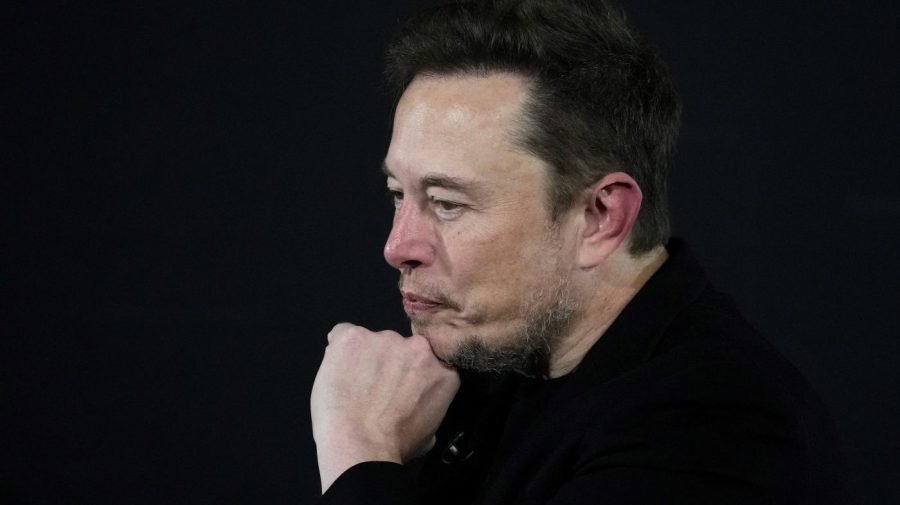Business
Musk told advertisers to ‘go f— yourself’ and stop spending on X. They might do just that. on December 7, 2023 at 11:00 am Business News | The Hill

Elon Musk’s recent expletive-laden outburst at major advertisers on X, the platform formerly known as Twitter, was the latest in a long line of controversial remarks from the billionaire tech mogul.
However, Musk’s comments may have gone too far for advertisers this time, who experts warned may opt not to continue spending on the platform.
“I think the era of advertising is true well and truly dead at Twitter, at X,” said Lou Paskalis, the CEO and founder of the marketing consultancy AJL Advisory.
Several major companies — including Disney, Apple, IBM, Comcast, Lionsgate, Warner Bros. Discovery, Sony Pictures and Paramount — paused their ad spending on the platform en masse last month as Musk faced renewed accusations of antisemitism.
The pullback started after Musk appeared to endorse an antisemitic conspiracy theory on X in a reply to another user’s post in mid-November, calling it the “absolute truth.”
Just one day later, a report from the left-leaning media watchdog Media Matters for America accused X of placing ads for mainstream brands next to pro-Nazi and white nationalist content.
As advertisers fled, Musk attempted to contain the fallout with a trip to Israel, in which he met with Israeli Prime Minister Benjamin Netanyahu and toured a kibbutz that was attacked by Hamas militants on Oct. 7.
However, upon returning to the U.S., Musk lashed out at major advertisers who had stopped spending on the platform.
“If someone is going to try and blackmail me with advertising, blackmail me with money, go f— yourself,” he said at The New York Times DealBook Summit. “Go f— yourself. Is that clear? Hope it is.
“Hey Bob, if you’re in the audience,” Musk added, in an apparent response to Disney CEO Bob Iger, who earlier in the summit addressed his company’s decision to halt spending on X.
Paskalis suggested that Musk already knew advertisers weren’t going to return to the platform before taking the stage at the DealBook Summit.
“Either out of hubris or a plan that I don’t understand, an end game I really don’t understand, he wanted to put the sword in the beast and say, ‘I don’t care about advertisers. Their concerns don’t concern me. I don’t need you to succeed,’” Paskalis told The Hill.
Advertisers flee as X bleeds money
Musk’s decision to spurn ad money comes after a year of deep financial losses for X, which the billionaire purchased for $44 billion last October.
Advertisers similarly pulled away last year after Musk initially took control of the company and rapidly began making changes. The billionaire fired top executives, laid off thousands of staff and followed through on promises to walk back content moderation policies and reinstate previously banned accounts on the platform.
By the end of November 2022, Media Matters reported that half of Twitter’s top 100 advertisers were no longer spending on the platform, and Musk was warning employees that the company could go bankrupt.
Since Musk’s chaotic takeover, advertisers appear to have slowly returned to X. CEO Linda Yaccarino said in September that 90 percent of the company’s top 100 advertisers were back, although some reports have indicated that ad revenue at X remains well below pre-Musk levels.
Wedbush Securities analyst Dan Ives said he now estimates that the social media company is worth less than $10 billion.
Why Musk’s latest comments are a turning point
Even more so than telling advertisers to “go f— yourself,” Paskalis said that Musk’s decision to publicly call out Iger has companies concerned.
“That is the more concerning thing for corporate America, that he would go so far to call out the CEO of somebody who’s stopped advertising,” he said. “That freezes large companies. It paralyzes them because they never want to put their CEO in any kind of thing that would get them caught up in the middle of the culture war.”
“In that context, if X paid me to advertise on X, if they actually paid a premium, money back to the client, it’s still not worth the reputational risk,” Paskalis added.
Jasmine Enberg, a principal analyst at the marketing research company Insider Intelligence, also said noted that because X is not essential for most advertisers, it is a “relatively painless and easy decision” for companies to cut spending on the platform.
“If it was a platform where advertisers got a strong return on investment, some of them might be more willing to overlook Musk’s antics,” Enberg said.
“But as it stands, X is a very small part of the digital advertising landscape, and there are other platforms and a growing list of other platforms where advertisers can spend their money,” she continued. “So why spend on a platform where the owner has explicitly told them not to.”
With the existence of these additional venues for advertising, Tom Hespos, who runs the consulting firm Abydos Media, said it has been easier for some of his clients to stop spending on the platform.
“Continuing to invest in Twitter when we have other options and they no longer have the clout and the control that they once did, again, the decision becomes a little bit more easy,” he told The Hill.
Hespos has begun recommending that some of his clients stop posting on X, in addition to halting ad spending.
“In the instance where I have a client that maybe hasn’t invested so much in Twitter, X, whatever its calling itself these days, it’s a consideration to pull not just advertising but to get off the platform entirely,” he said.
“Clients do not want to answer the questions surrounding, ‘Why are you supporting somebody who’s posted antisemitic things? Why are you supporting somebody who tells advertisers to f— off?’” he added.
Several major companies that halted ad spending on X seem to have taken a similar approach, with flagship accounts from Lionsgate, Warner Bros. Discovery, Sony Pictures and Paramount going silent in mid-November.
“We’re hitting a tipping point, I think, where the disdain for advertisers and the creation of a safe space for things like hate speech and antisemitism, those aren’t things that advertisers want to support through implied endorsement or any other methods,” Hespos said.
How Musk, X are trying to stay afloat
Amid the storm, X is reportedly working to attract ad spending from smaller and medium-sized businesses. The company told the Financial Times that the effort was “always part of the plan,” but it now plans to “go even further with it.”
Yaccarino has also attempted to attract advertisers with Musk’s “free speech” vision of the platform.
“X is enabling an information independence that’s uncomfortable for some people,” she wrote in a post last week. “We’re a platform that allows people to make their own decisions.”
“And here’s my perspective when it comes to advertising: X is standing at a unique and amazing intersection of Free Speech and Main Street — and the X community is powerful and is here to welcome you,” Yaccarino added. “To our partners who believe in our meaningful work — Thank You.”
However, experts expressed doubts about how effective such an approach will be at countering recent losses.
“Without those big brands, it’s going to be incredibly difficult for X to be able to pay its bills,” Enberg said. “Musk has not yet been able to roll out another sustainable monetization model that would be able to bring in as much revenue as advertising has brought in for the platform.”
While Ives, the Wedbush Securities analyst, acknowledged that X could use smaller businesses to “fill some of the void” left by major advertisers, he emphasized that they can’t replace them.
“I do think there’s going to have to be some olive branch to the advertisers to get them to come back at some point,” he said.
Ives noted that despite the current “groundswell moment,” he’s not entirely sure advertisers are done with the platform.
“On one hand, engagement on X has been, I think, significant,” he said. “Advertisers are focused on engagement, so do they come back slowly? I mean, that’s really that’s going to be the debate.”
“The world has short memories,” Ives added.
Technology, Business, advertisers, Twitter Elon Musk’s recent expletive-laden outburst at major advertisers on X, the platform formerly known as Twitter, was the latest in a long line of controversial remarks from the billionaire tech mogul. However, Musk’s comments may have gone too far for advertisers this time, who experts warned may opt not to continue spending on the platform….
Business
Why 9 Million Americans Have Left

The Growing American Exodus
Nearly 9 million Americans now live outside the United States—a number that rivals the population of several states and signals a profound shift in how people view the American dream. This mass migration isn’t confined to retirees or the wealthy. Thanks to remote work, digital nomad visas, and mounting pressures at home, young professionals, families, and business owners are increasingly joining the ranks of expats.

Rising Costs and Shrinking Wallets
Living in the US has become increasingly expensive. Weekly grocery bills topping $300 are not uncommon, and everyday items like coffee and beef have surged in price over the last year. Rent, utilities, and other essentials also continue to climb, leaving many Americans to cut meals or put off purchases just to make ends meet. In contrast, life in countries like Mexico or Costa Rica often costs just 50–60% of what it does in the US—without sacrificing comfort or quality.
Health Care Concerns Drive Migration
America’s health care system is a major trigger for relocation. Despite the fact that the US spends more per person on health care than any other country, millions struggle to access affordable treatment. Over half of Americans admit to delaying medical care due to cost, with households earning below $40,000 seeing this rate jump to 63%. Many expats point to countries such as Spain or Thailand, where health care is both affordable and accessible, as a major draw.

Seeking Safety Abroad
Public safety issues—especially violent crime and gun-related incidents—have made many Americans feel unsafe, even in their own communities. The 2024 Global Peace Index documents a decline in North America’s safety ratings, while families in major cities often prioritize teaching their children to avoid gun violence over simple street safety. In many overseas destinations, newly arrived American families report a significant improvement in their sense of security and peace of mind.
Tax Burdens and Bureaucracy
US tax laws extend abroad, requiring expats to file annual returns and comply with complicated rules through acts such as FATCA. For some, the burden of global tax compliance is so great that thousands relinquish their US citizenship each year simply to escape the paperwork and scrutiny.
The Digital Nomad Revolution
Remote work has unlocked new pathways for Americans. Over a quarter of all paid workdays in the US are now fully remote, and more than 40 countries offer digital nomad visas for foreign professionals. Many Americans are leveraging this opportunity to maintain their US incomes while cutting costs and upgrading their quality of life abroad.

Conclusion: Redefining the Dream
The mass departure of nearly 9 million Americans reveals deep cracks in what was once considered the land of opportunity. Escalating costs, inaccessible healthcare, safety concerns, and relentless bureaucracy have spurred a global search for better options. For millions, the modern American dream is no longer tied to a white-picket fence, but found in newfound freedom beyond America’s borders.
Business
Will Theaters Crush Streaming in Hollywood’s Next Act?

Hollywood is bracing for a pivotal comeback, and for movie lovers, it’s the kind of shake-up that could redefine the very culture of cinema. With the freshly merged Paramount-Skydance shaking up its strategy, CEO David Ellison’s announcement doesn’t just signal a change—it reignites the passion for moviegoing that built the magic of Hollywood in the first place.

Theatrical Experience Roars Back
Fans and insiders alike have felt the itch for more event movies. For years, streaming promised endless options, but fragmented attention left many longing for communal spectacle. Now, with Paramount-Skydance tripling its film output for the big screen, it’s clear: studio leaders believe there’s no substitute for the lights, the hush before the opening credits, and the collective thrill of reacting to Hollywood’s latest blockbusters. Ellison’s pivot away from streaming exclusives taps deep into what unites cinephiles—the lived experience of cinema as art and event, not just content.
Industry Pulse: From Crisis to Renaissance
On the financial front, the numbers are as electrifying as any plot twist. After years of doubt, the box office is roaring. AMC, the world’s largest theater chain, reports a staggering 26% spike in moviegoer attendance and 36% revenue growth in Q2 2025. That kind of momentum hasn’t been seen since the heyday of summer tentpoles—and it’s not just about more tickets sold. AMC’s strategy—premium screens, with IMAX and Dolby Cinema, curated concessions, and branded collectibles—has turned every new release into an event, driving per-customer profits up nearly 50% compared to pre-pandemic norms.
Blockbusters Lead the Culture
Forget the gloom of endless streaming drops; when films like Top Gun: Maverick, Mission: Impossible, Minecraft, and surprise hits like Weapons and Freakier Friday draw crowds, the industry—and movie fans—sit up and take notice. Movie-themed collectibles and concession innovations, from Barbie’s iconic pink car popcorn holders to anniversary tie-ins, have made each screening a moment worth remembering, blending nostalgia and discovery. The focus: high-impact, shared audience experiences that streaming can’t replicate.
Streaming’s Limits and Studio Strategy
Yes, streaming is still surging, but the tide may be turning. The biggest franchises, and the biggest cultural events, happen when audiences come together for a theatrical release. Paramount-Skydance’s shift signals to rivals that premium storytelling and box office spectacle are again at the center of Hollywood value creation. The result is not just higher profits for exhibitors like AMC, but a rebirth of movie-going as the ultimate destination for fans hungry for connection and cinematic adventure.

Future Forecast: Culture, Community, and Blockbuster Dreams
As PwC and others warn that box office totals may take years to fully catch up, movie lovers and industry leaders alike are betting that exclusive theatrical runs, enhanced viewing experiences, and fan-driven engagement are the ingredients for long-term recovery—and a new golden age. The Paramount-Skydance play is more than a business move; it’s a rallying cry for the art of the theatrical event. Expect more big bets, more surprises, and—finally—a long-overdue renaissance for the silver screen.
For those who believe in the power of cinema, it’s a thrilling second act—and the best seat in the house might be front and center once again.
Business
Why Are Influencers Getting $7K to Post About Israel?

Influencers are being paid as much as $7,000 per post by the Israeli government as part of an expansive and sophisticated digital propaganda campaign. This effort is designed to influence global public opinion—especially among younger social media users—about Israel’s actions in Gaza and to counter critical narratives about the ongoing humanitarian situation.

How Much Is Being Spent?
Recent reports confirm that Israel has dedicated more than $40 million this year to social media and digital influence campaigns, targeting popular platforms such as TikTok, YouTube, and Instagram. In addition to direct influencer payments, Israel is investing tens of millions more in paid ads, search engine placements, and contracts with major tech companies like Google and Meta to push pro-Israel content and challenge critical coverage of issues like the famine in Gaza.
What’s the Strategy?
- Influencer Contracts: Influencers are recruited—often with all-expenses-paid trips to Israel, highly managed experiences, and direct payments—to post content that improves Israel’s image.
- Ad Campaigns: State-backed ad buys show lively Gaza markets and restaurants to counter global reports of famine and humanitarian crisis.
- Narrative Management: These posts and ads often avoid overt propaganda. Instead, they use personal stories, emotional appeals, and “behind the scenes” glimpses intended to humanize Israel’s side of the conflict and create doubt about reports by the UN and humanitarian agencies.
- Amplification: Paid content is strategically promoted so it dominates news feeds and is picked up by news aggregators, Wikipedia editors, and even AI systems that rely on “trusted” digital sources.
Why Is This Happening Now?
The humanitarian situation in Gaza has generated increasing international criticism, especially after the UN classified parts of Gaza as experiencing famine. In this environment, digital public relations has become a primary front in Israel’s efforts to defend its policies and limit diplomatic fallout. By investing in social media influencers, Israel is adapting old-school propaganda strategies (“Hasbara”) to the era of algorithms and youth-driven content.
Why Does It Matter?
This campaign represents a major blurring of the lines between paid promotion, journalism, and activism. When governments pay high-profile influencers to shape social media narratives, it becomes harder for audiences—especially young people—to distinguish between authentic perspectives and sponsored messaging.

In short: Influencers are getting $7,000 per post because Israel is prioritizing social media as a battleground for public opinion, investing millions in shaping what global audiences see, hear, and believe about Gaza and the conflict.

 Business3 weeks ago
Business3 weeks agoDisney Loses $3.87 Billion as Subscription Cancellations Surge After Kimmel Suspension

 Entertainment3 weeks ago
Entertainment3 weeks agoWhat the Deletion Frenzy Reveals in the David and Celeste Tragedy

 Entertainment4 weeks ago
Entertainment4 weeks agoABC Suspends ‘Jimmy Kimmel Live!’ Indefinitely After Kirk Remarks

 Entertainment3 weeks ago
Entertainment3 weeks agoExecutive Producer Debut: How Celia Carver Created Festival Hit ‘Afterparty’

 Business4 weeks ago
Business4 weeks agoThe Rise Of Bullsh*t Jobs: Why Gen Z Hates Work

 Health3 weeks ago
Health3 weeks agoRussia Claims 100% Success With New mRNA Cancer Vaccine

 Film Industry4 weeks ago
Film Industry4 weeks agoCan Movie Theaters Steal the Show from Streaming?

 News4 weeks ago
News4 weeks agoBody of Missing Teen Found in Tesla Linked to Musician D4vd




























